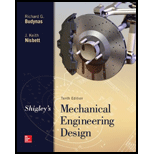
Concept explainers
2-21 to 2-23 A 1-in-diameter rod. 3 ft long, of unknown material is found in a machine shop. A variety of inexpensive nondestructive tests are readily available to help determine the material, as described below:
- (a) Visual inspection.
- (b) Scratch test: Scratch the surface with a file; observe color of underlying material and depth of scratch.
- (c) Check if it is attracted to a magnet.
- (d) Measure weight (±0.05 Ibf).
- (e) Inexpensive bending deflection test: Clamp one end in a vise, leaving 24 in cantilevered. Apply a force of 100 Ibf (±1 lbf). Measure deflection of the free end (within ± 1/32 in).
- (f) Brinell hardness test.
Choose which tests you would actually perform, and in what sequence, to minimize time and cost, but to determine the material with a reasonable level of confidence. The table below provides results that would be available to you if you choose to perform a given lest. Explain your process, and include any calculations. You may assume the material is one listed in Table A-5. If it is carbon steel, try to determine an approximate specification from Table A-20.
| Test | Results if test were made | ||
| Prob. 2-21 | Prob. 2-22 | Prob. 2-23 | |
| (a) | Dark gray, rough surface finish, moderate scale | Silvery gray, smooth surface finish, slightly tarnished | Reddish-brown, tarnished, smooth surface finish |
| (b) | Metallic gray, moderate scratch | Silvery gray, deep scratch | Shiny brassy color, deep scratch |
| (c) | Magnetic | Not magnetic | Not magnetic |
| (d) | W = 7.95 Ibf | W = 2.90 Ibf | W = 9.00 Ibf |
| (e) | δ = 5/16 in | δ = 7/8 in | δ = 17/32 in |
| (f) | HB = 200 | HB = 95 | HB = 70 |
Want to see the full answer?
Check out a sample textbook solution
Chapter 2 Solutions
Shigley's Mechanical Engineering Design (McGraw-Hill Series in Mechanical Engineering)
- please solve this problems follow what the question are asking to do please show me step by steparrow_forwardplease first write the line action find the forces and them solve the problem step by steparrow_forwardplease solve this problem what the problem are asking to solve please explain step by step and give me the correct answerarrow_forward
- please help me to solve this problem step by steparrow_forwardplease help me to solve this problem and determine the stress for each point i like to be explained step by step with the correct answerarrow_forwardplease solve this problem for me the best way that you can explained to solve please show me the step how to solvearrow_forward
- plese solbe this problem and give the correct answer solve step by step find the forces and line actionarrow_forwardplease help me to solve this problems first write the line of action and them find the forces {fx=0: fy=0: mz=0: and them draw the shear and bending moment diagram. please explain step by steparrow_forwardplease solve this problem step by step like human and give correct answer step by steparrow_forward
- PROBLEM 11: Determine the force, P, that must be exerted on the handles of the bolt cutter. (A) 7.5 N (B) 30.0 N (C) 52.5 N (D) 300 N (E) 325 N .B X 3 cm E 40 cm cm F = 1000 N 10 cm 3 cm boltarrow_forwardUsing the moment-area theorems, determine a) the rotation at A, b) the deflection at L/2, c) the deflection at L/4. (Hint: Use symmetry for Part a (θA= - θB, or θC=0), Use the rotation at A for Parts b and c. Note that all deformations in the scope of our topics are small deformation and for small θ, sinθ=θ).arrow_forwardDistilled water is being cooled by a 20% propylene glycol solution in a 1-1/U counter flow plate and frame heat exchanger. The water enters the heat exchanger at 50°F at a flow rate of 86,000 lbm/h. For safety reasons, the water outlet temperature should never be colder than 35°F. The propylene glycol solution enters the heat exchanger at 28°F with a flow rate of 73,000 lbm/h. The port distances on the heat exchanger are Lv = 35 in and Lh = 18 in. The plate width is Lw = 21.5 2 in. The plate thickness is 0.04 in with a plate pitch of 0.12 in. The chevron angle is 30° and the plate enlargement factor is 1.17. All ports have a 2 in diameter. The fouling factor of the propylene glycol solution can be estimated as 2 ×10−5 h-ft2-°F/Btu. a. Determine the maximum number of plates the heat exchanger can have while ensuring that the water outlet temperature never drops below 35°F. b. Determine the thermal and hydraulic performance of the heat exchanger with the specified number of plates.…arrow_forward
 Welding: Principles and Applications (MindTap Cou...Mechanical EngineeringISBN:9781305494695Author:Larry JeffusPublisher:Cengage Learning
Welding: Principles and Applications (MindTap Cou...Mechanical EngineeringISBN:9781305494695Author:Larry JeffusPublisher:Cengage Learning
